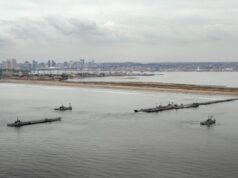In late May, President Obama addressed the graduating class at West Point. He said, “The most direct threat to America at home and abroad remains terrorism, but a strategy,” he continued, “that involves invading every country that harbors terrorist networks is naïve and unsustainable.” The chief reason to dismiss this railing against his predecessor is not that al-Qaeda executed several major terrorist attacks during Bush’s presidency—in Istanbul and Pakistan for example—which did not cause the administration to consider invasion. The more important fact is that no one argues that the U.S. should invade every country that harbors terror networks. This is not a straw man. It is a burnt straw man. It is a small mound of ashes in a room that no one enters.
The president follows public opinion in concentrating on terrorism as the threat to the U.S., based on his exclusively political calculation that the fear of another large terror attack on U.S. soil is the only foreign policy issue that could damage his administration. The result is a proportional diminution of the idea of American international leadership. “What makes us exceptional,” said the president, “is not our ability to flout international norms and the rule of law.” This argument cannot be addressed to anyone except those he wishes to convince that American inaction in the face of crises has been and will in the future be repeatedly absolved by a lack of international consent. That Mr. Obama wished to burnish his administration’s foreign policy record is understandable, but this vessel will not shine. Those, he said, “who suggest that America is in decline or has seen its global leadership slip away are either misreading history of engaged in partisan politics.”
I travel to Europe and speak with Asian visitors often. They want to know if the U.S. has lost interest in providing leadership to preserve the current world order. They inquire about the effectiveness of the Obama administration’s reset with Russia; about the crossed “red line” in Syria; about irresolute policy in Ukraine; about Iran’s progress toward status as a nuclear power; about the claim that bin Laden’s death had eliminated rather than metastasized Islamist terrorism; about the $1.2 trillion dollar budget cut that this administration is on track to achieve before it leaves office. Nothing suggests that my foreign interlocutors are “engaged in partisan politics.” And, if they are misreading history, where is their error?
They ask about the current administration’s “rebalance to Asia.” “Is it real?” they want to know. I look at China’s actions in the South and East China Seas and agree that the question is a good one. As May turned to June the contest between Hanoi and Beijing continued to smolder. China initiated it by moving a very large oil drilling rig close to islands that are the subject of dispute between Vietnam and China and lie within the former’s exclusive economic zone. The Guardian reported in late May that 21 people had died in the ensuing Vietnamese protests against China. Beijing evacuated 3,000 Chinese nationals. The incident is not over. On May 27, the BBC reported that a Chinese boat had rammed and sunk a Vietnamese fishing vessel that was operating within Vietnam’s exclusive economic zone.
China is conducting a two-part policy of incorporating the waters of the South and East China Seas within its sovereign grasp. The first part is lawfare, the use of dubious legalisms to assert claims and tighten Beijing’s grip. For example, China in November 2013 declared an Air Defense Identification Zone (ADIZ) over a large part of the East China Sea that includes Japan’s Senkaku Islands, which China claims. While such zones are established for the control of civil aircraft, they customarily do not include disputed territory. China’s ADIZ does. The second tine of the Chinese pitchfork is coercive. Today’s dispute over the oil rig China placed in Vietnam’s exclusive economic zone is deliberately aggressive as is the swarm of Chinese naval and civilian craft that were sent to escort and surround the billion-dollar oil platform.
The Obama administration’s answer to increased tension between Japan and China over the Senkaku Islands came in words. Secretary of Defense Hagel said that China’s “unilateral action increases the risk of misunderstanding and miscalculations.” So, the right words were used. The riots in Vietnam and evacuation of Chinese nationals in this incident do indeed indicate the large potential for miscalculation. Unfortunately, however, Hagel speaks for a department from whose budget it is his mission to wring every possible dollar. In the world of power politics to which we are returning after a short bout with more ideological confrontation, words unbacked by actions do not impress. And because they are unimpressed, our adversaries act—from Tehran to Donetsk to the international waters of the South and East China Seas. And thus, President Obama finds it necessary to impugn as partisan or uninformed those who ask whether America’s global leadership is at risk.
However, the administration’s massive defense budget cuts, noted above, are far more consequential than its “lead from behind” foreign policy. It may not be easy, but the president who takes office in January 2017 can reverse the current administration’s apologetic view of the American role in the world. But the military’s descent into hollowness will take years to turn back. And the U.S.’s re-emergence as the leader of the democratic states supported by a president who can explain to American voters why our political principles must be defended, promoted, and advanced in the world must be supported by a robust military.
Nowhere is the risk to U.S. forces more dangerous than in the enfeeblement of the Navy. Physically, seapower is the connective tissue that allows communication with our allies separated from us by the world’s oceans. Morally, it is the shield that assures our allies as it confines the prospect of conflict to other continents. But our seapower is declining. The fleet today is less than half the size it was under Ronald Reagan. The Navy has been reducing the size of the fleet it hopes to achieve. Both the Congressional Budget Office and Congressional Research Service agree that the Navy’s projected shipbuilding budgets are substantially short of the funds required to build even the shrinking fleet that is the Navy’s objective. Earlier this year, the Obama administration postponed the question of whether to refuel an aircraft carrier, the USS George Washington, or allow—contrary to law—the number of U.S. aircraft carriers to fall below 11. The Obama administration proposed that the Navy stop purchasing its highly effective Tomahawk cruise missile after 2015. And the question of a replacement to the aging Ohio-class nuclear-powered ballistic missile submarine (SSBN)—for which a single boat would consume a major portion of the Navy’s shipbuilding budget—hangs in the balance. If the Navy is forced to pay this expense out of future shipbuilding budgets that do not expand proportionately, the unfortunate administration official from the Pentagon who said in March that defense budget cuts mean that the pivot to Asia “can’t happen” will be proved right. The surface and attack submarine vessels that are needed to carry out the administration’s planned increase in naval presence in the Western Pacific will be at risk from the prohibitive cost of a new class of SSBN.
However, in the meantime, the current administration is chiefly occupied by talking and diplomatic visits. When it does more than talk, it heads for the courts. Again, in May, the media reported on the Justice Department’s indictments of Chinese nationals for hacking against American firms. The likelihood that those indicted, who live in China, will be turned over to American authorities is low. The similarity to previous administrations that treated terror as a purely criminal, and thus legal, issue is high. China’s cyber-attacks against the U.S. government and important commercial nodes are crimes indeed. But they are a form of the undeclared warfare conducted as part of the strategic competition between China and the U.S. that the former acknowledges and the latter denies.
More effective than criminal indictments would be a significantly increased American military presence in the Asia-Pacific. A U.S. shipbuilding budget that can actually achieve the Navy’s 306-ship fleet goal would help convince both Asian allies and potential adversaries that our deeds follow our words and that we understand that the Obama administration’s “smart power” without supporting hard power is no power. Adding two aircraft carrier battle groups to the one that is now homeported in Asia would also be a convincing demonstration of American resolve. So would an allied purchase of the two large amphibious ships that France plans to sell to Russia. These large vessels in Crimea would give Russia control of the Black Sea as well as dramatically shift the balance of power to our disadvantage in the Eastern Mediterranean. Based elsewhere, they could add significantly to Russia’s Pacific fleet. Alternately, purchased by the West, they could be divided between Australia, South Korea, or even Vietnam. Placing them in the naval arsenals of Asian states that are in China’s sights would also strengthen allies and help persuade Beijing that coercion will not achieve its’ objectives.
An additional need is growing as a result of China’s 2,000 land-based theater ballistic missiles whose reach includes our Pacific bases as well as regional allies. Along with these should be counted North Korea’s arsenal—about half the size of China’s—of theater ballistic missiles that threaten not only our allies, but also U.S. bases as distant as Alaska. The warning systems needed to detect attacks from this expanding and dangerous array together with the United States’ missile defenses against it need to be enlarged. The Pacific Command’s May 29th announcement that a pair of long distance surveillance drones will be deployed to a base in northern Japan to monitor North Korean nuclear and Chinese naval activity is a step in the right direction. Much more needs to be done.
Two challenges face U.S. strategy today: the jihadists and the possibility that rather than a new world order, we will see a return to the old world order, the one that flourished as warfare based on religion and individual monarchs’ ambitions sundered Europe. Through the Treaty of Westphalia in the middle of the 17th century, a successful effort was undertaken to respect borders and, by implication, religious differences. The search for a modern international order began in Westphalia. Such order is viewed with as much contempt by the jihadists as by China and Russia—except where they benefit. Principle does not exist where it is honored only when an individual or a state regards it in their interest. A successful U.S. strategy would acknowledge this. A rebalance to Asia cannot be at the expense of existing interests in concluding the war with jihadism on our terms, or assuring the security of the Eastern Mediterranean, or our allies in Europe and Israel. And a rebalance to Asia cannot be effective unless it includes both the diplomatic, economic and military instruments that our friends find as reassuring as our competitors find persuasive.
Seth Cropsey is the Director of the Hudson Institute’s Center for American Seapower. He served as deputy undersecretary of the U.S. Navy in the Reagan and George H. W. Bush administrations and is the author of Mayday: The Decline of American Naval Supremacy.





